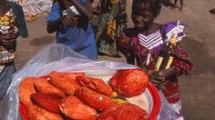Abstract
Couepia is a genus distributed in tropical regions of America. The nut of some Couepia species is used as fresh fruit and oil source for local communities. Despite its critical situation of conservation and its economic potential, there is a lack of information on the genetic variability of Couepia species. This study examines AFLP variation among 40 accessions of Couepia collected in the Colombian Amazonian region, representing two species: Couepia dolichopoda and Couepia subcordata. The individuals were examined for 96 markers generated from four EcoRI/MseI primer pairs, with 80% polymorphism across all accessions studied. According to cluster analysis, 40 accessions were grouped into two major clusters, corresponding to the two species analyzed, except one case whose situation is discussed. In C. dolichopoda accessions, significant correlation between the clustering pattern and the geographical origin was detected; the extent of variation within and among its collect sites was examined by AMOVA. The knowledge about the genetic variability of the accessions examined contributes to development of Couepia conservational efforts.



Similar content being viewed by others
References
Bassam B, Caetano-Anollés G, Gresshoff P (1991) Fast and sensitive silver staining of ADN in polyacrylamide gels. Annu Biochem 196:80–83
Calderón E, Galeano G, García N (eds) (2002) La serie de libros rojos de especies amenazadas de Colombia: Libro rojo de plantas fanerógamas de Colombia Vol. 1 Chrysobalanaceae, Dichapetalaceae y Lecythidaceae. Instituto Alexander von Humboldt, ICN-UN, UN, Minambiente, Bogotá, Colombia
Chaudry B, Yasmeen A, Husnain T, Riazuddin S (1999) Mini-scale genomic DNA extraction from cotton. Plant Mol Biol Rep 17:1–7
Clay J, Clement C (1993) Income generating forest and conservation in Amazonia. FAO Forestry Paper. FAO, Rome
Dice L (1945) Measures of the amount of ecologic association between species. Ecology 26:297–302
FAO (1996) Desarrollo de productos forestales no madereros para América Latina y el Caribe. FAO, Rome
Huff D, Peakall R, Smouse P (1993) RAPD variation within and among natural populations of outcrossing buffalograss [Buchloë dactyloides (Nutt.) Engelm.]. Theor Appl Genet 86:927–934
Kim C, Lee C, Shin J, Chung Y, Hyung N (1997) A simple and rapid method for isolation of high quality genomic ADN from fruit trees and conifers using PVP. Nucleic Acids Res 25:1085–1086
Kovach W (1998) MVSP-A multivariate statistical package. Ver 3.12d. Kovach Computing Services. Pentraeth, Wales, UK
Maguire T, Peakall R, Saenger P (2002) Comparative analysis of genetic diversity in the mangrove species Avicennia marina (Forsk.) Vierth. (Avicenniaceae) detected by AFLPs and SSRs. Theor Appl Genet 104:388–398
Mantel N (1967) The detection of disease clustering and a generalized regression approach. Cancer Res 27:209–220
Müller G (2001) Chrysobalanaceae. In: Hanelt P and Institute of Plant Genetics and Crop Plant Research (eds) Mansfeld’s encyclopedia of agricultural and horticultural crops, vol 1. Springer, Berlin, pp 533–539
Peakall R, Smouse P (2001) GenAlEx V5: Genetics analysis in Excel. Population genetic software for teaching and research. Australian National University, Canberra, Australia
Prance G (2001) Chrysobalanaceae. In: Bernal R, Forero E (eds) Flora de Colombia. Instituto de Ciencias Naturales, Universidad Nacional de Colombia, Unibiblios, Bogotá, Colombia
Rohlf F (1993) NTSYS-pc: numerical taxonomy and multivariate C. subcordata analysis system, version 2.0. Exeter software, Setauket, New York
Sneath P, Sokal R (1973) Numerical taxonomy: the principles and practice of numerical classification. W.H. Freeman, San Francisco
Vos P, Hogers R, Bleeker M, Reijans R, van de Lee T, Hornes M, Frijters A, Pot J, Peleman J, Kuiper M, Zabeau M (1995) AFLP: a new technique for DNA fingerprinting. Nucleic Acids Res 23(21):4407–4414
Acknowledgements
We thank all the teams of general project “Conservación, Manejo y Aprovechamiento Sostenible de nueces promisorias pertenecientes al género Couepia por comunidades de veredas de los municipios Puerto Rico y Morelia, Caquetá”, funded by “Fondo para la Acción Ambiental”. Special thanks to the Molecular Biology Laboratory team of SINCHI institute.
Author information
Authors and Affiliations
Corresponding author
Rights and permissions
About this article
Cite this article
Rozo, Y., Quintero, L., Parra, M. et al. Analysis of genetic variability in Couepia accessions using AFLP markers. Genet Resour Crop Evol 56, 77–83 (2009). https://doi.org/10.1007/s10722-008-9346-6
Received:
Accepted:
Published:
Issue Date:
DOI: https://doi.org/10.1007/s10722-008-9346-6




